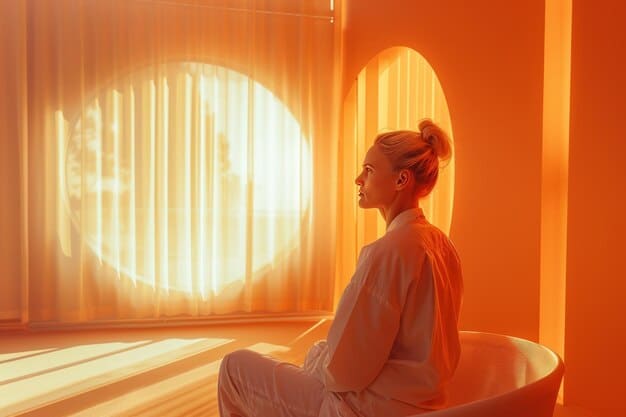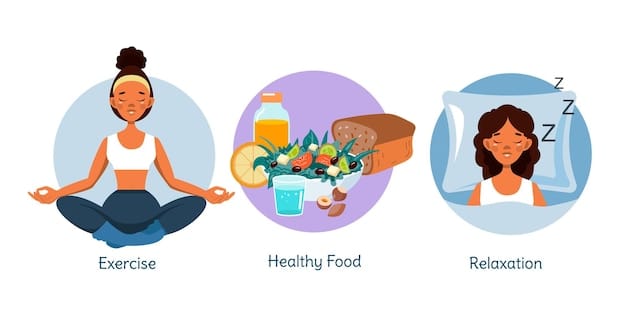Understanding SAD: Symptoms & Solutions for US Residents

Understanding Seasonal Affective Disorder (SAD) involves recognizing its symptoms, which often mirror depression but are tied to specific seasons, and exploring effective solutions available to US residents, ranging from light therapy to lifestyle adjustments.
Are you feeling down as the days get shorter? You might be experiencing Seasonal Affective Disorder (SAD). Understanding Seasonal Affective Disorder (SAD): Symptoms and Solutions for US Residents is crucial, and this guide will explore what SAD is, how it affects people in the US, and what you can do to combat its effects.
What is Seasonal Affective Disorder (SAD)?
Seasonal Affective Disorder (SAD) is more than just the “winter blues.” It’s a recognized form of depression that occurs at specific times of the year, most commonly during the fall and winter months. Understanding its cyclical nature is the first step toward managing its impact.
While the exact cause of SAD isn’t fully understood, it’s often linked to reduced sunlight exposure during the shorter days of fall and winter. This disruption can affect your body’s internal clock (circadian rhythm), leading to changes in mood and energy levels.
Impact on Circadian Rhythm
The circadian rhythm is a 24-hour internal clock that regulates sleep-wake cycles and other bodily functions. Reduced sunlight can cause this clock to become out of sync, triggering SAD symptoms. This can affect the production of vital mood-regulating hormones like melatonin and serotonin.
Role of Melatonin and Serotonin
Melatonin, a hormone that regulates sleep, is produced in higher levels during darkness. The lack of sunlight can lead to overproduction of melatonin, making you feel sleepy and lethargic. Serotonin, a neurotransmitter that affects mood, is also impacted by sunlight exposure. Lower serotonin levels are associated with depression.
- Sunlight and Serotonin: Sunlight helps boost serotonin production, which is crucial for maintaining a positive mood.
- Melatonin Regulation: Proper light exposure helps regulate melatonin levels, promoting healthy sleep patterns.
- Circadian Alignment: Maintaining a consistent sleep schedule, even on weekends, can help keep your circadian rhythm aligned.

Recognizing the interplay between these factors is key to understanding SAD and developing effective strategies to mitigate its effects. If you suspect you have SAD, it’s important to seek professional evaluation.
Identifying SAD Symptoms in US Residents
Identifying SAD can be tricky, as its symptoms often overlap with other forms of depression. However, the seasonal pattern sets it apart. Recognizing these symptoms early is crucial for seeking timely intervention and relief.
In the US, the most common time for SAD to manifest is during the late fall and winter months, when daylight hours are significantly reduced. Symptoms typically start mild and gradually worsen as the season progresses.
Common Physical Symptoms
SAD can present with a range of physical symptoms that affect your daily functioning. These symptoms often mirror those of typical depression but have a distinct seasonal pattern.
Emotional and Behavioral Changes
Emotional and behavioral symptoms can significantly impact your quality of life. These changes can affect your relationships, work, and overall well-being.
- Persistent Sadness: A prevailing feeling of sadness or hopelessness that lasts for days or weeks.
- Loss of Interest: Diminished interest or pleasure in activities you once enjoyed.
- Social Withdrawal: Tendency to isolate yourself from friends and family.
- Irritability: Increased irritability or restlessness.
If you experience these symptoms consistently during specific seasons, it’s important to consult with a healthcare professional. Early diagnosis can lead to more effective treatment strategies.
Effective Solutions and Treatments for SAD
Fortunately, SAD is a manageable condition with several effective treatments and lifestyle adjustments available. The goal is to combat the effects of reduced sunlight and restore balance to your body’s natural rhythms.
Treatment options range from light therapy to medication and lifestyle changes, tailored to individual needs and preferences. A combination of approaches often yields the best results.
Light Therapy
Light therapy is a first-line treatment for SAD. It involves sitting near a special light box that emits bright light, mimicking natural sunlight. The light helps to regulate your circadian rhythm and boost serotonin levels.
Medication
Antidepressants, particularly selective serotonin reuptake inhibitors (SSRIs), can also be effective in treating SAD. These medications help increase serotonin levels in the brain, alleviating depressive symptoms. Consult with a healthcare provider to determine if medication is right for you.

- Morning Use: Light therapy is most effective when used in the morning for about 20-30 minutes.
- Adjustments: Dosage and type of medication should be closely monitored and adjusted by a healthcare professional.
- Therapy Benefits: Combining medication with psychotherapy can provide comprehensive support.
Remember, finding the right treatment strategy may require some experimentation. Working closely with healthcare professionals can help you navigate the options and develop a personalized plan.
Lifestyle Adjustments to Combat SAD
In addition to formal treatments, lifestyle adjustments can play a significant role in managing SAD symptoms. These changes focus on enhancing your overall well-being and resilience during the challenging seasons.
Incorporating these practices into your daily routine can improve your mood, energy levels, and overall quality of life. Consistency is key to seeing the benefits.
Regular Exercise
Physical activity is a powerful mood booster. Regular exercise can help reduce stress, improve sleep, and increase serotonin levels. Aim for at least 30 minutes of moderate-intensity exercise most days of the week.
Healthy Diet
A balanced diet rich in fruits, vegetables, and whole grains can provide essential nutrients that support brain health and mood regulation. Avoid processed foods, sugary drinks, and excessive caffeine, which can worsen symptoms.
- Outdoor Activities: Even on cloudy days, spending time outdoors can provide some exposure to natural light.
- Mindfulness Practices: Incorporate mindfulness exercises, meditation, or yoga to reduce stress and improve emotional regulation.
- Social Connections: Stay connected with friends and family, even when you feel like withdrawing. Social support can buffer against SAD symptoms.
By proactively managing your lifestyle, you can build a stronger foundation for coping with SAD. Combine these adjustments with professional treatment for a comprehensive approach.
Seasonal Affective Disorder in Different US Regions
The prevalence and impact of SAD can vary across different regions of the US, largely due to varying degrees of sunlight exposure during the fall and winter months. Residents of northern states, in particular, face unique challenges.
Understanding these regional differences can help tailor prevention and treatment strategies to meet specific needs. Public health initiatives can also be more effectively targeted.
Northern States
Northern states, such as Alaska, Maine, and Minnesota, experience significantly shorter days and longer periods of darkness during winter. This increased lack of sunlight can lead to a higher incidence of SAD among residents.
Southern States
Southern states, like Florida, California, and Arizona, generally have more sunlight throughout the year. However, even in these regions, some individuals may still experience SAD, although the severity and prevalence might be lower.
- Light Therapy: Increased access to light therapy resources in northern communities.
- Awareness Campaigns: Targeted awareness campaigns to educate residents about SAD symptoms and prevention strategies.
- Community Programs: Development of community-based programs that promote social support and outdoor activities, even during winter months.
Recognizing these regional variations is crucial for addressing SAD effectively. Public health strategies can be tailored to meet the specific needs of different communities across the US.
Seeking Professional Help for SAD
Knowing when and how to seek professional help is crucial for managing SAD effectively. While lifestyle adjustments and self-care strategies can be beneficial, they may not be sufficient for everyone. A healthcare professional can provide a proper diagnosis and recommend appropriate treatments.
Don’t hesitate to reach out if your symptoms are persistent, severe, or interfering with your daily life. Early intervention can prevent SAD from significantly impacting your overall well-being.
When to See a Doctor
Consider consulting a healthcare professional if you experience persistent symptoms of depression during specific seasons, particularly if these symptoms interfere with your work, relationships, or daily activities.
Types of Professionals to Consult
Several types of healthcare professionals can help diagnose and treat SAD. These include primary care physicians, psychiatrists, psychologists, and licensed therapists.
- Comprehensive Evaluation: Expect a thorough evaluation, including a review of your medical history, symptoms, and seasonal patterns.
- Treatment Options: Discuss treatment options, such as light therapy, medication, psychotherapy, or a combination of approaches.
- Collaborative Approach: Work collaboratively with your healthcare provider to develop a personalized treatment plan that addresses your specific needs and preferences.
Taking the step to seek professional help is a sign of strength and self-awareness. The right support can make a significant difference in managing SAD and improving your quality of life.
| Key Point | Brief Description |
|---|---|
| ☀️ Light Therapy | Uses bright light to mimic sunlight, helping regulate circadian rhythm and boost serotonin. |
| 💊 Medication | Antidepressants like SSRIs can help increase serotonin levels, alleviating depressive symptoms. |
| 💪 Exercise | Regular physical activity reduces stress, improves sleep, and increases serotonin levels. |
| 🍎 Healthy Diet | A balanced diet supports brain health and mood regulation, avoiding processed foods and excessive caffeine. |
Frequently Asked Questions (FAQ)
▼
SAD is a type of depression that’s related to changes in seasons, typically beginning and ending around the same months each year. Most often, SAD starts in the fall and continues into the winter months, sapping your energy and making you feel moody.
▼
Common symptoms include feeling sad or down most of the day, nearly every day, losing interest in activities you once enjoyed, experiencing changes in appetite or weight, having problems with sleep, feeling sluggish or agitated, and having difficulty concentrating.
▼
Treatment for SAD may include light therapy, where you sit near a special light box to mimic natural sunlight, psychotherapy to help manage symptoms and develop coping strategies, and medication, such as antidepressants, to help balance neurotransmitter levels.
▼
Yes, lifestyle changes can significantly help. Regular exercise, a balanced diet, maintaining a consistent sleep schedule, spending time outdoors, and engaging in social activities can all help improve mood and reduce SAD symptoms.
▼
You should seek professional help if your SAD symptoms are severe, persistent, or significantly interfering with your daily life. A healthcare provider can provide an accurate diagnosis and recommend appropriate treatment options tailored to your needs.
Conclusion
Understanding Seasonal Affective Disorder (SAD): Symptoms and Solutions for US Residents is essential for effectively managing this condition. By recognizing the symptoms, understanding the available treatments, and seeking professional help when needed, individuals in the US can mitigate the impact of SAD and maintain their well-being throughout the year.





